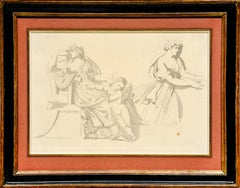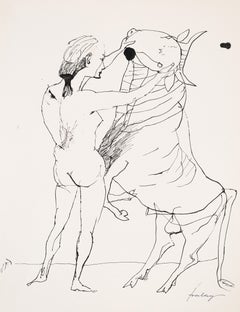Paris - Figurative Drawings and Watercolors
Early 1800s Old Masters Paris - Figurative Drawings and Watercolors
Paper, Pencil, Ink
2010s Outsider Art Paris - Figurative Drawings and Watercolors
Paper, Color Pencil, Graphite
1870s Academic Paris - Figurative Drawings and Watercolors
Watercolor
Late 20th Century Contemporary Paris - Figurative Drawings and Watercolors
Paper, Ink
1920s Art Deco Paris - Figurative Drawings and Watercolors
Pencil
2010s Paris - Figurative Drawings and Watercolors
Oil, Canvas
Early 20th Century Modern Paris - Figurative Drawings and Watercolors
Pencil
1950s Modern Paris - Figurative Drawings and Watercolors
Ink, Laid Paper
1710s Old Masters Paris - Figurative Drawings and Watercolors
Chalk
2010s Contemporary Paris - Figurative Drawings and Watercolors
Ink, Paper
2010s Contemporary Paris - Figurative Drawings and Watercolors
Paper, India Ink
Early 1900s Symbolist Paris - Figurative Drawings and Watercolors
Pencil
Early 1900s Symbolist Paris - Figurative Drawings and Watercolors
Pencil
2010s Contemporary Paris - Figurative Drawings and Watercolors
Monotype, Paper
2010s Contemporary Paris - Figurative Drawings and Watercolors
Paper, India Ink
Late 19th Century French School Paris - Figurative Drawings and Watercolors
Charcoal, Laid Paper
1790s Paris - Figurative Drawings and Watercolors
Watercolor
1930s Art Deco Paris - Figurative Drawings and Watercolors
Pastel
1780s Baroque Paris - Figurative Drawings and Watercolors
Watercolor
Mid-18th Century Old Masters Paris - Figurative Drawings and Watercolors
Chalk
1920s Post-Impressionist Paris - Figurative Drawings and Watercolors
Pastel
Early 20th Century Paris - Figurative Drawings and Watercolors
Charcoal
Late 20th Century Modern Paris - Figurative Drawings and Watercolors
Gouache, Paper
1880s Academic Paris - Figurative Drawings and Watercolors
Watercolor
Early 20th Century Paris - Figurative Drawings and Watercolors
India Ink
1960s Abstract Paris - Figurative Drawings and Watercolors
Chalk, Paper
1990s Modern Paris - Figurative Drawings and Watercolors
Ink
1930s Art Deco Paris - Figurative Drawings and Watercolors
Chalk, Charcoal
Early 1900s Realist Paris - Figurative Drawings and Watercolors
Charcoal, Pencil
1890s Art Nouveau Paris - Figurative Drawings and Watercolors
Ink
Mid-20th Century Paris - Figurative Drawings and Watercolors
Charcoal
19th Century French School Paris - Figurative Drawings and Watercolors
Watercolor
2010s Contemporary Paris - Figurative Drawings and Watercolors
Paper, India Ink
1840s Romantic Paris - Figurative Drawings and Watercolors
Carbon Pencil
1920s Art Deco Paris - Figurative Drawings and Watercolors
Pastel
1880s Romantic Paris - Figurative Drawings and Watercolors
Graphite
Early 20th Century Modern Paris - Figurative Drawings and Watercolors
Paper, Watercolor
2010s Contemporary Paris - Figurative Drawings and Watercolors
Paper, India Ink
1910s Academic Paris - Figurative Drawings and Watercolors
Carbon Pencil, Color Pencil
2010s Contemporary Paris - Figurative Drawings and Watercolors
Paper, India Ink
1870s Academic Paris - Figurative Drawings and Watercolors
Charcoal, Paper
2010s Contemporary Paris - Figurative Drawings and Watercolors
Oil, Paper
Late 19th Century Paris - Figurative Drawings and Watercolors
Charcoal
19th Century Paris - Figurative Drawings and Watercolors
Paper, Ink, Gouache
1910s Academic Paris - Figurative Drawings and Watercolors
India Ink
2010s Abstract Paris - Figurative Drawings and Watercolors
Ink, Paper
Early 1900s Paris - Figurative Drawings and Watercolors
Color Pencil
Early 20th Century Paris - Figurative Drawings and Watercolors
Ink, India Ink
1890s Art Nouveau Paris - Figurative Drawings and Watercolors
Ink
Mid-20th Century Modern Paris - Figurative Drawings and Watercolors
India Ink, Watercolor
Mid-20th Century Modern Paris - Figurative Drawings and Watercolors
Carbon Pencil
2010s Contemporary Paris - Figurative Drawings and Watercolors
Gouache, Paper
1890s Art Nouveau Paris - Figurative Drawings and Watercolors
Ink
Early 1900s Impressionist Paris - Figurative Drawings and Watercolors
Watercolor
1970s Paris - Figurative Drawings and Watercolors
India Ink, Watercolor, Pencil
1910s Academic Paris - Figurative Drawings and Watercolors
Pencil
2010s Contemporary Paris - Figurative Drawings and Watercolors
Ink, Watercolor, Permanent Marker, Color Pencil, Pen
Mid-20th Century Realist Paris - Figurative Drawings and Watercolors
Charcoal, Watercolor, Gouache
Early 1900s Symbolist Paris - Figurative Drawings and Watercolors
Pencil
Early 1900s Symbolist Paris - Figurative Drawings and Watercolors
Pencil




